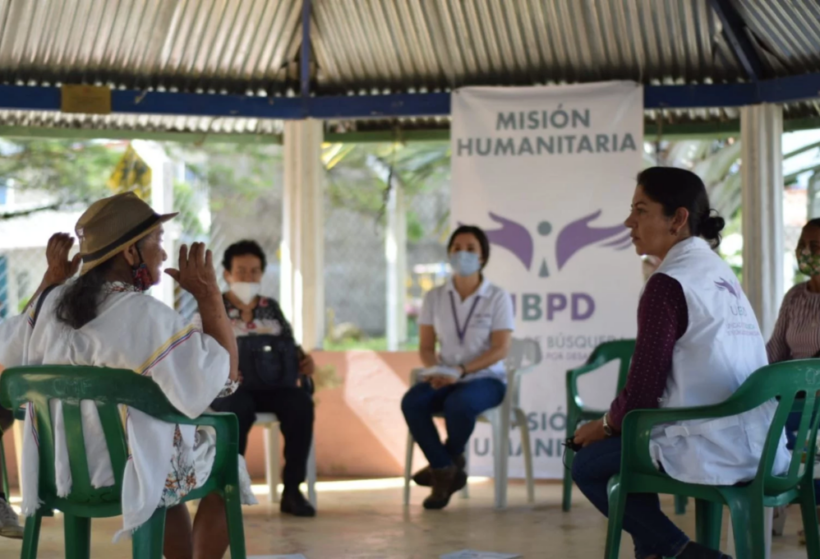Ten Colombian departments have signed Regional Pacts for the Search for Disappeared Persons in order to work together to find the country’s disappeared. Antioquia, one of the departments most affected by this phenomenon, was one of the first to adopt this strategy.
By Emmanuel Zapata Bedoya
Photo: UBPD archive
Since December 2020, the Unit for the Search for Missing Persons (UBPD) has been promoting the signing of Regional Pacts for the Search for Missing Persons in the country, with the aim of strengthening the searches undertaken by the State and providing coordinated responses between institutions for victims who need to know the whereabouts of their relatives.
The Regional Pacts aim to “achieve an articulated and coordinated response from the institutions to the victims, as well as to make it known that around 120,000 people were disappeared in the context of the Colombian armed conflict. This figure exceeds the number of disappearances recorded in dictatorships and conflicts in Latin America, including Argentina, Chile and Guatemala, which have 30,000, 10,000 and 45,000 disappeared persons respectively”, states the UBPD on its website.
When reviewing the numbers of victims and those affected by this practice, the data presented by the repositories are very different, but equally concerning. According to the Single Register of Victims (RUV), between 1985 and 31 May 2023, enforced disappearances left 51,263 victims.
For its part, according to the Truth Commission, between 1985 and 2016, 121 768 people were forcibly disappeared in Colombia; however, the Commission clarifies that due to the under-reporting of these cases, the figure may be as high as 210 000 victims. Meanwhile, the UBPD counts 103,955 missing persons in the country, a figure which, it warns, may increase over the years.
Its unity also claims that nine of the country’s 32 departments account for 60 per cent of enforced disappearances. These departments are: Antioquia, Meta, Magdalena, Valle del Cauca, Cesar, Santander, Caquetá, Norte de Santander and Putumayo. In eight of these nine departments, Regional Search Pacts have already been signed and implemented.
The first department to sign was Meta on 4 December 2020. It was followed by Magdalena on 25 February 2021; then Antioquia, the department most affected by this phenomenon, on 11 March of the same year. Bogotá-Cundinamarca, Valle del Cauca and Caquetá signed in April; Norte de Santander signed the Parto Regional two months after, on 10 June; Nariño on 8 July; Cesar on 27 August and Santander on 10 December 2021.
The signing of the Regional Pacts brought together social organisations, leaders, human rights defenders, governors, mayors and victims of the Colombian armed conflict in order to work together to find the whereabouts of the disappeared in these regions.
The Government of Antioquia stated that it would “join forces to contribute to the search for missing persons in the territory”, taking into account that it is the department most affected by the Colombian armed conflict, since according to the Observatory of Memory and Conflict of the National Centre of Historical Memory, from 1958 to 2016, 20,279 cases of enforced disappearance were registered.
The pacts in Eastern Antioquia
Ten municipalities in Eastern Antioquia, in coordination with the UBPD, came together to learn about the reality of enforced disappearance in their territories. “In this project, the communities were organised to support the search for the disappeared because they did not have more information about the situation in each of the municipalities and it was found that the figures were upward, mainly in the municipalities of San Luis, San Francisco, Cocorná, Granada, San Carlos, San Rafael, Sonsón, Argelia and Nariño, these being the ten selected to work on the issue”, explains Nelson Duque, leader and searcher from San Luis.
In these municipalities, Municipal Pacts for the Search for Missing Persons were signed, one in each territory. The signing included the mayors’ offices, the municipal peace councils, the municipal peace councils, the victims’ roundtables and other organisations committed to contributing to the search for missing persons in eastern Antioquia.
“The project was developed, the Regional Search Support Committees were created and an attempt was made to put together the universe of each of the municipalities to find out how many disappeared people they had, which is not complete information either, because the information is particular in many cases. What the project did was to make visible the magnitude of the problem in each municipality in the region and raise awareness of it,” Duque said.
In addition, two other pacts were signed in specific municipalities: the Regional Pact for the Search, signed in Puerto Berrio, Antioquia; and the Municipal Pact for the Search, in Santa Rosa del Sur, in the department of Bolívar. Although they are political in nature, like the Pacts mentioned in previous paragraphs, the latter make sense when their geographical location and the dynamics of the armed conflict in these areas are known.
In Puerto Berrio, the Pact was signed on 18 March 2021 in order to show that this was one of the municipalities, not only in Antioquia, but also in the country, most affected by forced disappearance. According to the Observatory of Memory and Conflict of the National Centre of Historical Memory, 852 cases were registered between 1958 and 2016.
In Santa Rosa del Sur, the pact was signed on 30 August 2022, the most recent signing of the Pacts. According to the UBPD, “in Santa Rosa del Sur 97 people have been identified as missing, a figure that obliges us to act because of the suffering of the families who are searching”.
It is hoped that these Covenants will serve to speed up the search for missing persons at the local level and contribute to the work that the Unity has been mandated to do.










